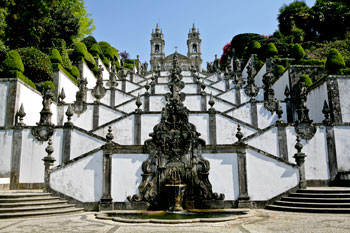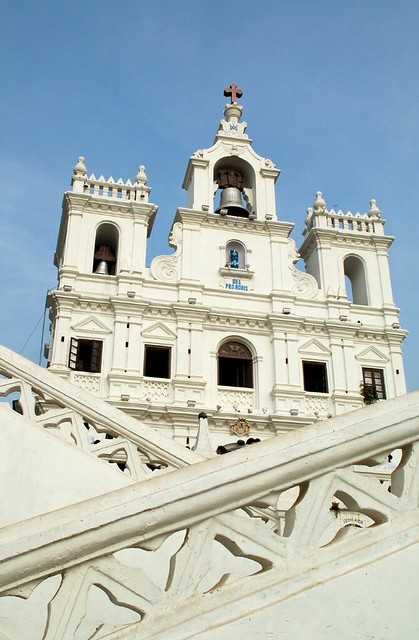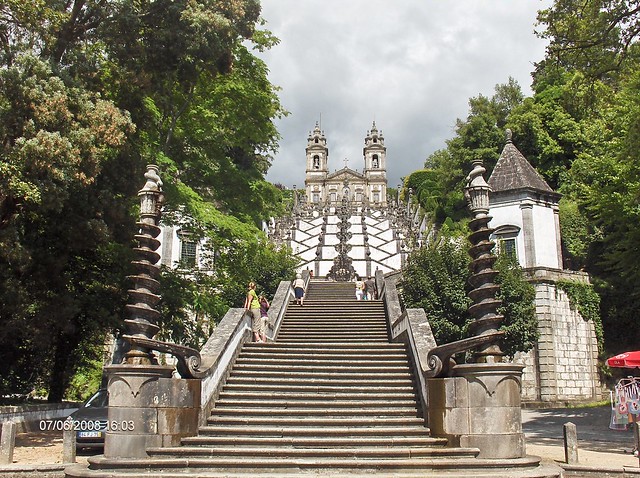Growing up in
Panjim those who knew would tell you that the monumental staircase that adds so
much drama to the façade of the church of the Immaculate Conception was an
imitation of a similar staircase in the church of Bom Jesus in the Portuguese
city of Braga. These suggestions of ‘colonial’ productions being imitations are
always disturbing. It suggests that all innovations happen only in the
metropole and those in the provinces and colonies are capable only of
imitation. A more favourable reading would suggest that both metropole and
provinces are engaged in conversations with a similar model but express
themselves differently, as they should.
 In any case, the
staircase that gives access to the church of Bom Jesus in Braga is of an
entirely different scale. Where Panjim’s
stairway is largely composed of a couple of sets of mirroring steps, the
stairway in Braga is composed of two elements. The first is a stairway that is
not symmetrical, but initiates the visitor to the stations of the cross that
form the central element that binds these two staircases together, uniting them
with the church whose main altar is given to the crucifixion of Christ. It is
the second staircase that is composed, like that in Panjim, of a number of
steps that mirror each other. And this is where the difference lies, for while
the stairs leading to the Panjim church seek to impress with bulk, those of the
Bom Jesus are composed of dizzying repetition of elements finally emerging like
filigree.
In any case, the
staircase that gives access to the church of Bom Jesus in Braga is of an
entirely different scale. Where Panjim’s
stairway is largely composed of a couple of sets of mirroring steps, the
stairway in Braga is composed of two elements. The first is a stairway that is
not symmetrical, but initiates the visitor to the stations of the cross that
form the central element that binds these two staircases together, uniting them
with the church whose main altar is given to the crucifixion of Christ. It is
the second staircase that is composed, like that in Panjim, of a number of
steps that mirror each other. And this is where the difference lies, for while
the stairs leading to the Panjim church seek to impress with bulk, those of the
Bom Jesus are composed of dizzying repetition of elements finally emerging like
filigree. A number of
tourists to the church choose to drive up to the church and then walk down the
staircases. Or, they choose to motor it up part of the way, and then walk up
the second, more impressive staircase. In my enthusiasm to get the whole
experience I began to engage with the staircase well before the more
symmetrical portion of the stairway began. Walking through a tree lined avenue
I passed through the baroque gates that announced the beginning of the
staircase and began the ascent. In addition to the chapels that host
sentimental terracotta images of Christ in the course of his passion, there are
a number of fountains through the length of this part of this stairway. If the
chapels of the stations provide a sombre Christian element to this walk, the
fountains that mark the path add an oddly pagan twist given that each of them
is dedicated to a planet.
A number of
tourists to the church choose to drive up to the church and then walk down the
staircases. Or, they choose to motor it up part of the way, and then walk up
the second, more impressive staircase. In my enthusiasm to get the whole
experience I began to engage with the staircase well before the more
symmetrical portion of the stairway began. Walking through a tree lined avenue
I passed through the baroque gates that announced the beginning of the
staircase and began the ascent. In addition to the chapels that host
sentimental terracotta images of Christ in the course of his passion, there are
a number of fountains through the length of this part of this stairway. If the
chapels of the stations provide a sombre Christian element to this walk, the
fountains that mark the path add an oddly pagan twist given that each of them
is dedicated to a planet.
The one feature
that really caught my eye, however, were two fountains that stood at the start
to this second ascent. They were not in operation on the day I visited, but the
principle of their working was obvious enough. The fountain was crafted to
represent a serpent twined around a pillar, water shot out of the mouth of the
serpent into a basin and then spun around the body all around the pillar to
finally continue its way down the hill. How brilliantly over the top was that!
 Looking at this
entire production, statuary, fountains, and the whole nine yards, it was clear
as the light of day. The stairs of the church of the Immaculate Conception in
Panjim are no imitation of the staircase in Braga. This latter edifice was in a
completely different order altogether. No, the authors of the work in Panjim
were working toward a similar but definitely different project.
Looking at this
entire production, statuary, fountains, and the whole nine yards, it was clear
as the light of day. The stairs of the church of the Immaculate Conception in
Panjim are no imitation of the staircase in Braga. This latter edifice was in a
completely different order altogether. No, the authors of the work in Panjim
were working toward a similar but definitely different project.
(A version of this post was first published in The Goan on April 12, 2014)


